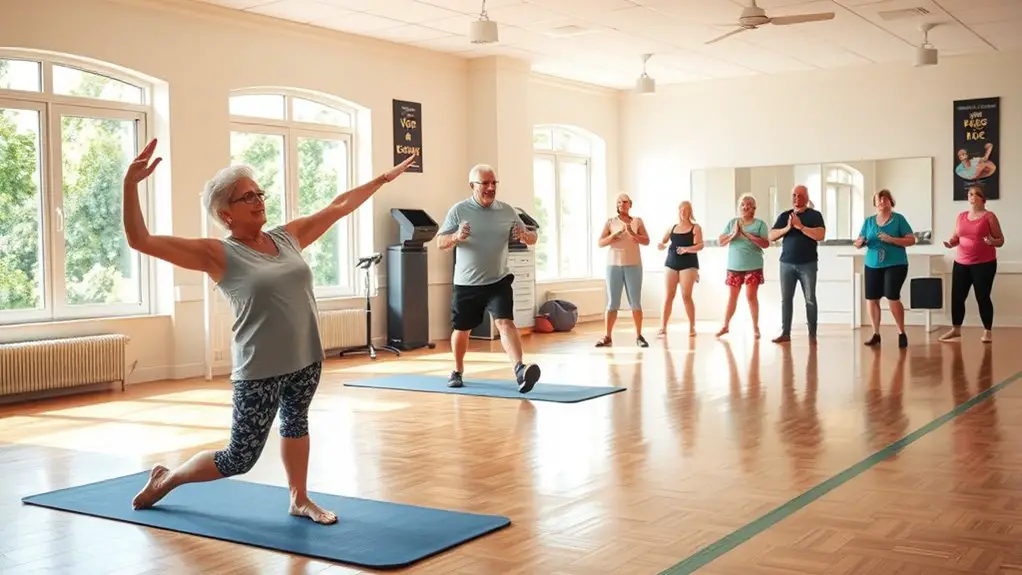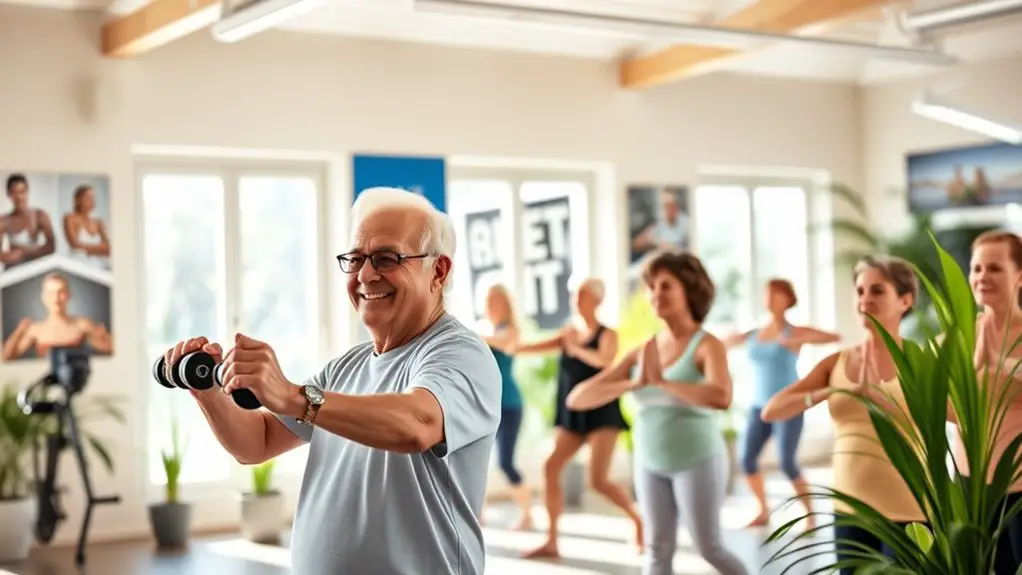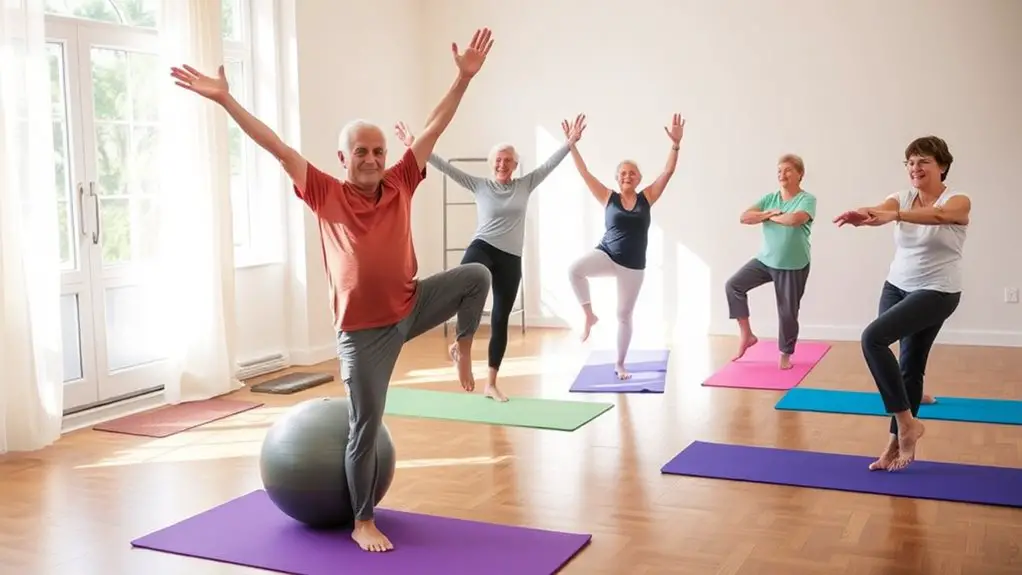The Best Gym Routines for Retirees Who Want to Stay Fit

Staying fit in retirement is key to living a healthy and fulfilling life. Start with low-impact cardio like walking or aquatic aerobics to boost your heart health without straining your joints. Incorporate strength training twice a week to improve balance and maintain muscle mass. Don’t forget flexibility and balance exercises like yoga or tai chi to enhance coordination and reduce the risk of falls. There’s so much more you can explore to stay active and vibrant!
Importance of Fitness in Retirement

Staying active during retirement isn’t just about keeping fit; it’s a key ingredient for a vibrant life. Regular exercise can greatly boost your mental health, helping to reduce anxiety and depression while improving your mood. When you stay active, you’re more likely to feel energized and engaged, making it easier to tackle new hobbies or interests.
Additionally, fitness can enhance your social connections. Joining a gym or participating in group classes not only keeps you physically fit but also provides opportunities to meet like-minded individuals. These interactions foster friendships and create a sense of community, which is essential for emotional well-being.
Moreover, maintaining your fitness routine can help you stay independent longer, allowing you to enjoy your retirement fully. Incorporating activities like skipping can boost energy levels and contribute to a healthier lifestyle. So, whether it’s walking, swimming, or lifting weights, remember that embracing fitness can lead to a healthier, happier retirement.
Understanding Your Fitness Level
Before diving into any exercise routine, it’s crucial to assess your fitness level. Knowing where you stand not only helps you set realistic personal goals but also guarantees you choose the right activities for your body. A fitness assessment can guide you in this process. Here are three key components to reflect on:
- Strength: Evaluate how much weight you can lift and your endurance in resistance exercises.
- Flexibility: Test your range of motion with simple stretches to prevent injury.
- Cardiovascular Health: Monitor your heart rate during light activities to gauge your stamina.
Understanding these areas will allow you to tailor your workouts effectively. By recognizing your strengths and weaknesses, you can create a balanced routine that aligns with your personal goals, making sure you stay fit and active in your retirement years.
Low-Impact Cardio Options

While you may be looking for ways to stay active without putting too much strain on your joints, low-impact cardio options can be a great solution. One of the simplest and most accessible forms of low-impact exercise is walking workouts. Whether you prefer a leisurely stroll in the park or a brisk walk on a treadmill, walking can help improve your cardiovascular health while being gentle on your body.
Another excellent option is aquatic aerobics. Exercising in water not only reduces the impact on your joints but also provides resistance, making your workout more effective. Many gyms offer classes tailored specifically for seniors, allowing you to engage with others while you stay fit. Additionally, incorporating skipping without a rope can offer a fun and effective way to enhance your cardiovascular fitness while being easy on your joints.
Incorporating these low-impact cardio activities into your routine can help keep you active and energized, promoting overall well-being as you age. Just remember to listen to your body and adjust your intensity as needed.
Strength Training for Seniors
As you age, incorporating strength training into your fitness routine can be incredibly beneficial, not just for maintaining muscle mass but also for enhancing overall mobility and stability. Using resistance bands and your own body weight can be a great way to start. Here are three key benefits of strength training for seniors:
- Improved Balance: Strength training helps stabilize muscles and joints, reducing the risk of falls.
- Increased Endurance: Regular sessions can boost your stamina, making daily activities easier and more enjoyable.
- Enhanced Bone Health: Lifting weights or using resistance bands can strengthen bones, lowering the risk of osteoporosis.
Aim for at least two days a week of strength training, focusing on major muscle groups. Remember, it’s essential to start slow and consult with a healthcare provider if you’re unsure about how to begin. You’ll be amazed at how quickly you can feel stronger and more agile!
Flexibility and Balance Exercises

Incorporating flexibility and balance exercises into your routine can greatly enhance your quality of life as you age. These exercises improve mobility, reduce the risk of falls, and can even boost your mood. Activities like yoga and tai chi not only increase flexibility but also offer relaxation benefits.
Here’s a quick guide to some effective flexibility and balance exercises:
| Exercise | Benefits | How to Get Started |
|---|---|---|
| Yoga | Improves flexibility and peace of mind | Join a class or follow an online video |
| Tai Chi | Enhances balance and coordination | Find a local group or practice at home |
| Standing Leg Lifts | Strengthens legs and core | Hold onto a chair for support |
| Seated Hamstring Stretch | Increases lower body flexibility | Sit on the floor and reach for your toes |
Frequently Asked Questions
What Equipment Is Best for Home Workouts for Retirees?
When you’re setting up for home workouts, you’ll want equipment that’s both effective and easy to use. Resistance bands are fantastic for strength training; they’re versatile and can adapt to your fitness level. Stability balls are great too, as they help improve balance and core strength. Together, these tools can create a thorough workout routine that keeps you active and engaged. Plus, they’re compact and perfect for any living space!
How Often Should Retirees Change Their Workout Routine?
You should change your workout routine every 4 to 6 weeks to maintain motivation and effectiveness. Incorporating routine variety keeps your body challenged and helps prevent plateaus. It’s vital to take into account workout frequency as well; aim for at least three to five sessions per week. This balance guarantees you’re not only working different muscle groups but also enjoying your workouts, which is key to staying fit and engaged in your fitness journey.
Can Retirees Participate in Group Fitness Classes?
Group fitness classes can be a fantastic fit for retirees. They offer social support and dynamic class variations that keep things exciting. You’ll benefit from the positive group dynamics, making workouts more enjoyable and motivating. Plus, these classes often cater to different fitness levels, ensuring you can participate comfortably. So, don’t hesitate to plunge into these energetic environments; it’s a great way to stay active and connect with others!
What Are Some Signs to Stop Exercising?
When it comes to exercise, knowing when to stop is vital. If you experience any sudden pain, dizziness, or shortness of breath, it’s time to listen to your body. Other health indicators, like swelling or extreme fatigue, may signal exercise limitations. Don’t push through discomfort; instead, take a break and assess your situation. Staying attuned to these signs can help you maintain a safe and effective fitness routine.
Are Fitness Trackers Beneficial for Seniors?
Imagine a garden, where each plant needs sunlight and water to thrive. Fitness trackers work the same way for you—they help monitor your activity levels and keep your fitness goals in sight. They can encourage you to stay active, reminding you to move when you’ve been sitting too long. Plus, they provide valuable feedback, making it easier to adjust your routine as needed. So, yes, they’re definitely beneficial for seniors looking to stay fit!





